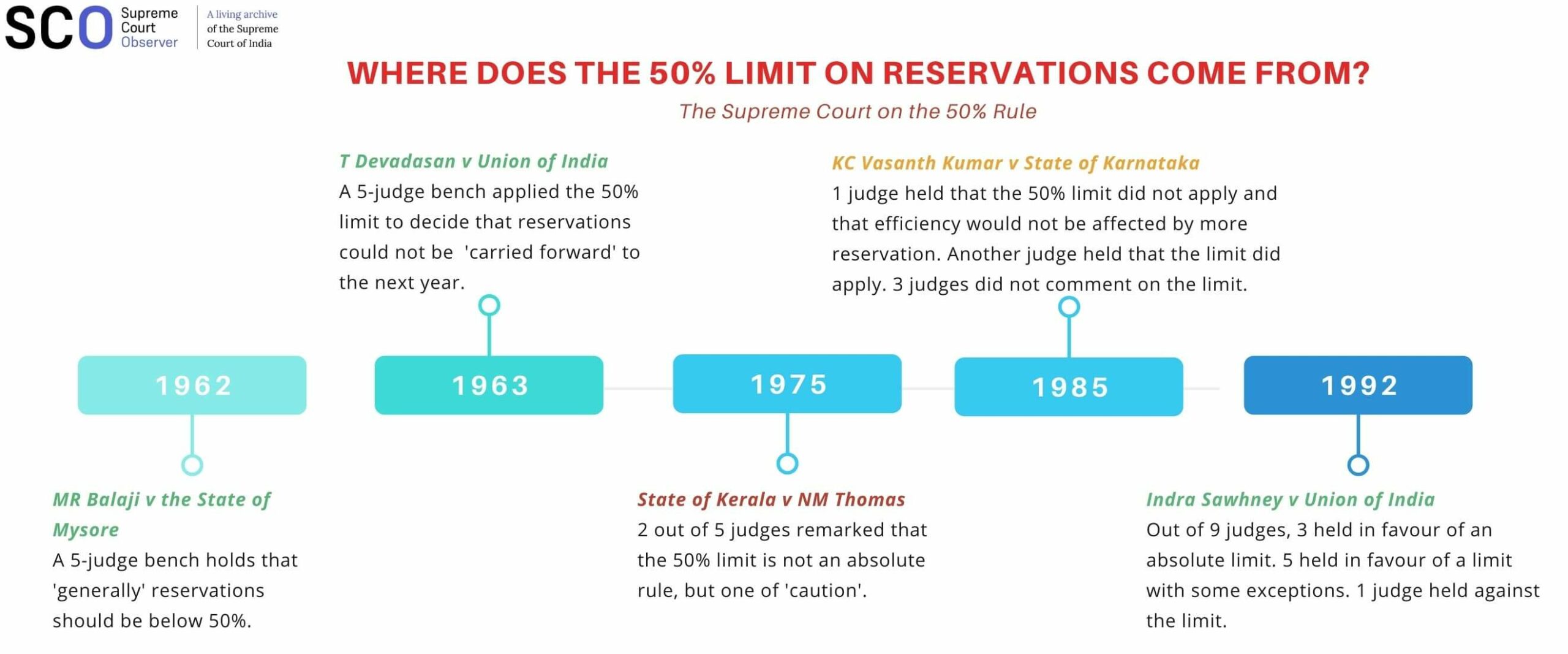Analysis
Do Reservations Have to be Below 50%? From Balaji [1962] to Indra Sawhney [1992]
The ceiling limit for reservation as laid down in Indra Sawhney v Union of India has been challenged in several subsequent cases.

The Constitution of India, 1950 enshrined an important, transformative tool for social mobility: reservations. Various cases over the years have dealt with the question of how these reservations can be granted. One of the most crucial ones is Indra Sawhney v Union of India. This 1992 case laid down a ceiling limit within which reservations can be granted: more than 50% of positions should not be reserved (the ‘50% rule’). Today, this rule might seem unsettled.
In 2018, the Maharashtra government passed the Socially and Educationally Backward Classes Act, 2018. This law introduced 16% reservations for Marathas in State services and higher education: this pushed the overall reservation to over 50%. The petitioners who challenged this law have sought to rely on the 50% rule. Meanwhile, the respondents have sought to overturn the rule or carve out a broad exception. In this post, we examine the rationale behind the rule and its development prior to Indra Sawhney.
Reservations find their basis in multiple parts of the Constitution. For legislatures, seats are reserved under Articles 330 and 332. Seats can be reserved for employment in government services under Article 16(4). And after the 1st Constitutional Amendment, Article 15(4) allowed for ‘special provisions’. This has been used to grant reservations in various other fields, notably higher education.
Various Southern States had often implemented reservations for not just SCs/STS, but other backward classes as well. In 1962, the State of Mysore reserved a total of 68% of seats for various backward classes. This was challenged in MR Balaji v the State of Mysore. A five-judge bench of the Supreme Court, for the first time, talked about ensuring that reservations remained below 50%.
It rejected the argument that reservations do not affect the quality of scholarship or efficiency. Although the judges in Balaji did not cite it, the petitioners arguing against Maratha reservations have relied on Article 335 of the Constitution. This article requires ‘efficiency of administration’ to be a consideration when making provisions for SCs/STs. They have argued that this is a broader principle of efficiency, relevant to higher education, states and all special provisions for any backward classes. Thus reservations should be kept to a minimum. This narrative has often been challenged by anti-caste authors. Merit is a function of privilege, they argue.
Balaji also held that the rights of deserving candidates from other communities should also be kept in mind. Accordingly, ‘special provisions’ like Article 15(4) and Article 16(4) should be restricted to ‘reasonable limits’. So, reservations must be kept below 50% of seats. How much below 50% would depend on the circumstances, said the Court.
When the judgment in Balaji was pronounced, the Court had held reservations under Article 15(4) and 16(4) to be an ‘exception’ to the formal principles of equality in Articles 15(1) and 16(1). Since then, various judgments, including Indra Sawhney have rejected this interpretation. Instead, it is seen as an ‘enabling provision’ to further equality. The respondents have argued that the 50% rule only made sense when it was an exception since the exception cannot overtake the general rule. Now, the rule should no longer hold.
In T Devadasan v Union of India, the 50% rule was applied to hold ‘carry-forward’ reservations unconstitutional. This meant that unfilled seats for reserved categories in one year could not be carried forward to the next year. The 50% rule seemed to have become an accepted constitutional principle.
However, in NM Thomas v State of Kerala, the rule was cast in the shadow of a doubt. A five-judge bench of the Supreme Court dealt with the question of reservation in promotions. In this case, two judges remarked that the rule may not apply. Justice Fazal Ali said it was a ‘rule of caution’. If 80% of a State’s population was backward, then it would not necessarily be unconstitutional to provide for 80% reservations, he noted. Justice Krishna Iyer agreed and said that the limit cannot be ‘pressed too far’. The other judges did not explicitly deal with the rule, but the judgment altogether placed it on uneven footing.
In KC Vasanth Kumar v State of Karnataka, two judges were split on the issue. The rule was no longer absolute. Notably, an important authority in favour of the rule was also invoked: Dr. Ambedkar in the Constituent Assembly had commented that reservations should be ‘confined to a minority of seats’. He had explained to the Assembly that this was necessary in order to ensure equality of opportunity. The respondents have argued that this speech can no longer be relied on. They say that this too was said in the context of Article 16(4) being an ‘exception’, and the Court has held otherwise.
With this background, when the challenge in Indra Sawhney came, the Court had to put an end to the 50% ceiling limit issue. In the next post, we look at this case and subsequent developments. The case was deemed to have ruled in favour of a 50% rule. The respondents in the Maratha Reservation case have argued that Indra Sawhney was wrongly decided. If the five-judge bench is not convinced about the strength of the Indra Sawhney precedent, it is likely to return us to the uncertainty around the limit of reservations. The only, recourse then would be for the five-judge bench to refer Indra Sawhney to eleven-judge bench.
